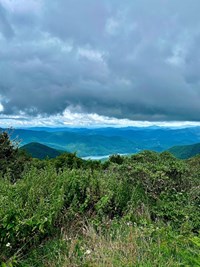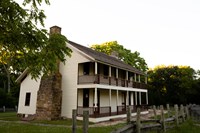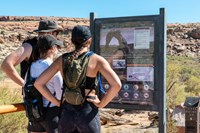- Pea Ridge National Military Park (37)
- Buffalo National River (10)
- Wilson's Creek National Battlefield (9)
- Arkansas Post National Memorial (7)
- Fort Smith National Historic Site (7)
- George Washington Carver National Monument (7)
- Hot Springs National Park (7)
- Fort Scott National Historic Site (6)
- Lincoln Boyhood National Memorial (6)
- Show More ...
- Heartland Inventory & Monitoring Network (3)
- Wildland Fire Program (3)
- Eastern Rivers and Mountains Inventory & Monitoring Network (2)
- Fire and Aviation Management (2)
- Geologic Resources Division (2)
- North Coast and Cascades Inventory & Monitoring Network (2)
- Appalachian Highlands Inventory & Monitoring Network (1)
- Archeology Program (1)
- Arctic Inventory & Monitoring Network (1)
- Show More ...
Showing 89 results for PERI ...
Leasing Opportunity: Pea Ridge National Military Park Hay Lease
- Type: Article
Pea Ridge National Military Park has announced a Request for Bids (RFB), providing the opportunity for interested individuals and organizations to submit bids to the National Park Service (NPS) to lease one storage facility and NPS lands for haying purposes. The facility and property for lease are located at the park at 15930 National Park Drive, Garfield, Arkansas 72732. The Premises includes one storage building (98.15 square feet) and approximately 600 acres of land.
- Type: Article
You can be a Heartland Inventory and Monitoring Network Junior Scientist! Explore what it is like to be a scientist that monitors plants, animals, and their habitats national parks. You will explore the 15 parks of the Heartland Network, make observations, identify animals and plants, and learn why scientists use scientific names for organisms. Visit a Heartland Network Park to complete the activities in the booklet or download the booklet here.
Park Store and Information
- Type: Place
The Visitor Center/Park Store is open Thursday - Sunday (4 days per week) from 10am to 4pm, inside the Sandburg Home. The online park store is open everyday! The Park Store and visitor information area is a great place to start your visit! You can find information to plan your visit, get a passport stamp, participate in the Jr Ranger or BARK Ranger programs, and get a schedule of upcoming events. The park store has a wide range of Sandburg books, media, and other items.
Cathay Williams
- Type: Article
After being mere spectators at the war's early battles, civilians both near and far from the battlefields became unwilling participants and victims of the war as its toll of blood and treasure grew year after year. In response to the hardships imposed upon their fellow citizens by the war, civilians on both sides mobilized to provide comfort, encouragement, and material, and began to expect that their government should do the same.
Midway Geyser Basin Trailhead
- Type: Place
Midway Geyser Basin is small but spectacular. Excelsior Geyser is a 200 x 300 foot crater that constantly discharges more than 4,000 gallons of water per minute into the Firehole River. Grand Prismatic Spring, Yellowstone's largest hot spring, is 200-330 feet in diameter and more than 121 feet deep. Hot SpringsHot springs are the most common hydrothermal features in Yellowstone. Their plumbing has no constrictions. Superheated water cools as it reaches the surface, sinks, and
- Type: Article
The National Park Service will increase native seed availability for plants in the mixed grass and tallgrass prairie of the Central U.S., advancing the National Seed Strategy priorities. The project will support established relationships with academic, interagency, and Tribal partners, as well as other stakeholders for seed production.
Asheville Watershed
- Type: Place
Located between Milepost 355 and 370 along the Blue Ridge Parkway, the Asheville Watershed is where Asheville gets it water. It has the capacity to produce and deliver 43 million gallons of water to city residents per day. The North Fork Reservoir, one of two artificial lakes within the watershed, is visible from several overlooks along the Parkway.
- Type: Article
In early December 2007, a series of three Pacific storms struck coastal Oregon and Washington. Later named the “Great Coastal Gale of 2007,” these storms brought in heavy rains, severe temperature swings, and hurricane force winds exceeding 100 miles per hour to Lewis and Clark National Historical Park. Ten years later, the forest looks very different. How is the park using remote sensing technology to monitor landscape change?
Picnic Grove 2
Elkhorn Tavern
Delicate Arch Trail
- Type: Place
This trail hikes up 538 feet (164 m) to the most famous arch in the park, crossing open slickrock with no shade. Pass historic Wolfe Ranch and a rock markings panel, then climb steadily; follow the rock cairns and signs. Just before you get to Delicate Arch, the trail traverses a narrow rock ledge for about 200 yards (183 m). Take at least 2 quarts (2 L) of water per person. Roundtrip distance: 3 miles (4.8 km) Time: 2-3 hours
- Type: Article
The Heartland Inventory and Monitoring Network has monitored deer at Pea Ridge National Military Park since 2005. Deer are charismatic creatures that were nearly extinct in the early 1900s. Now deer overpopulation is a significant problem that can lead to overbrowsing of park trees and other plants, increasing deer-vehicle collisions, and the spread of disease. We monitor deer to help the park make management decisions that protect deer, park ecosystems, and people.
Park Prepares for 2015 Bat Surveys
- Type: Article
White-nose syndrome (WNS) is a serious disease affecting North American bats. It is caused by the fungus Pseudogymnoascus destructans and has resulted in the death of millions of bats in the United States and Canada. Bats are crucial to ecosystem function and provide billions of dollars per year to agriculture in insect suppression services alone. Despite efforts to contain it, WNS continues to spread.
- Type: Article
To steward amphibians effectively, managers need basic information about which species live in parks. But species lists need constant maintenance to remain accurate. Due to recent efforts, the National Park Service now has an up-to-date amphibian species checklist for almost 300 parks. This information can serve as the basis for innumerable conservation efforts across the nation.
Mt. Baldy Beach Trail
- Type: Place
Mount Baldy is 126 feet above the water level of Lake Michigan and is moving inland at about 4 feet per year. Beach sand on the dune moves when the prevailing northwest wind exceeds 7 mph. The movement of Mount Baldy is made worse because there is no longer sand collecting at the water's edge to bolster the dune. Beach erosion is taking away more sand from Mount Baldy than the waves are bringing in due to the breakwall that was built for the Michigan City Harbor.




















